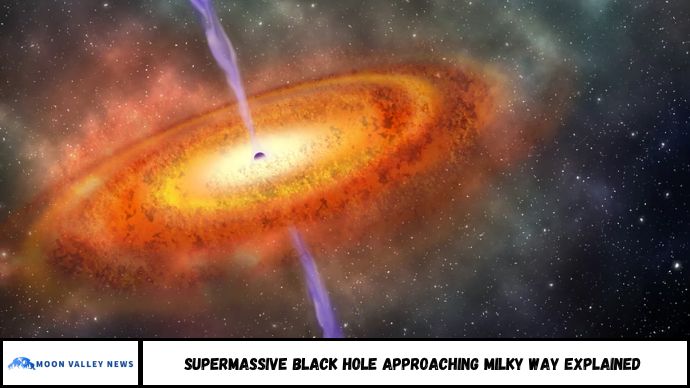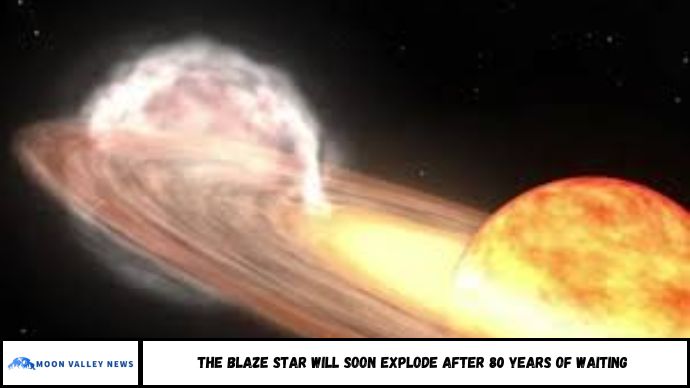A supermassive black hole heading toward the Milky Way galaxy has sparked public curiosity and concern. While this cosmic event may sound alarming, current data from astronomers shows it’s billions of light-years away and won’t affect Earth anytime soon. In this article, we break down what this black hole is, how fast it’s moving, what its trajectory means, and whether there’s any real risk to our solar system.
The unusual motion of hypervelocity stars has led scientists to suspect that a supermassive black hole may be hiding inside a nearby dwarf galaxy. If true, this discovery would imply that a future collision with the Milky Way is not just possible—but inevitable.
Back in 1971, two British astronomers first proposed the idea of a black hole lurking at the center of our galaxy. Just a few years later, in 1974, other researchers confirmed the presence of Sagittarius A*, a supermassive black hole now known to anchor the Milky Way.
Since then, astronomers have found that nearly every large galaxy appears to host a similar black hole at its core. In fact, in 2019, scientists captured the first-ever image of a supermassive black hole, marking a major milestone in astrophysics. These cosmic giants are now considered essential to how galaxies are formed, shaped, and sustained over time.
But what about smaller galaxies, like the Large Magellanic Cloud—a dwarf satellite galaxy expected to merge with the Milky Way in about 2.4 billion years? Whether such dwarf galaxies also harbor supermassive black holes remains a mystery. However, recent stellar motion patterns hint that they just might.
Is the Milky Way in Danger from a Black Hole?
It sounds like the plot of a sci-fi thriller: a runaway supermassive black hole, millions of times heavier than our Sun, is hurtling through space—and it’s headed in the general direction of the Milky Way.
Should we panic? Are we witnessing the beginning of a galactic disaster?
The short answer is: no, but it’s a fascinating phenomenon that reveals just how dynamic and powerful the universe is. In this article, you’ll discover what makes this supermassive black hole unique, why it’s moving at incredible speeds, and what scientists expect to happen millions (or even billions) of years from now.
What Is a Supermassive Black Hole?
A supermassive black hole (SMBH) is a gravitational beast that can contain millions to billions of solar masses. They are typically found at the center of galaxies—including our own Milky Way, which hosts Sagittarius A*.
Key traits of SMBHs:
- Massive gravitational pull
- Invisible, but detectable by surrounding effects
- Fuel galaxy formation and dynamics
The one heading our way is no ordinary black hole—it was ejected from its home galaxy due to a rare and violent event.
Why Is This Supermassive Black Hole Moving?
This cosmic wanderer was likely flung from its galaxy by a galactic collision or gravitational slingshot, caused by the interaction of multiple black holes. When three black holes meet during a galaxy merger, one can be ejected at high velocity.
NASA’s Hubble Space Telescope confirmed in early 2023 the existence of such a runaway SMBH, traveling at nearly 4 million miles per hour (about 6.4 million km/h).
At that speed, it could travel from Earth to the Moon in less than 14 minutes—but again, it’s not anywhere near us.
Where Is the Black Hole Now—and Is It a Threat?
According to research published in The Astrophysical Journal Letters, this black hole is approximately 230 million light-years away in the constellation Coma Berenices. While it appears to be headed toward the general direction of the Milky Way, space is vast, and even “heading toward” doesn’t guarantee a collision.
Why It’s Not a Threat:
- It would take billions of years to reach the Milky Way (if ever).
- Galaxies are mostly empty space—chances of a direct hit are astronomically low.
- The Milky Way is constantly moving and changing direction, too.
What Makes This Event Important to Science?
This discovery offers rare insights into:
- Galaxy formation and mergers
- Black hole dynamics
- The effects of gravitational waves
Additionally, the trail of stars left behind by the black hole offers clues about its origin and speed. Scientists believe it’s pulling a stream of stars along its path, similar to a cosmic wake.
“We’ve never seen anything like it before,” said Pieter van Dokkum, astrophysicist at Yale University. “It’s a supermassive black hole on the run, and it’s moving fast.”
Will the Milky Way Eventually Collide with Another Galaxy?
Yes—but not because of this black hole. The Andromeda Galaxy is on a collision course with the Milky Way, expected to happen in about 4.5 billion years. That collision could disrupt both galaxies’ structures, possibly forming a new one—nicknamed Milkomeda by scientists.
Even in such an event, individual star systems are unlikely to collide because of the vast distances between them.
FAQs
1. Is the black hole really heading toward the Milky Way?
Yes, but it’s millions of light-years away and poses no current threat.
2. How fast is the black hole moving?
Around 4 million mph—one of the fastest-moving SMBHs ever observed.
3. Could it reach Earth?
Highly unlikely. It would take billions of years, and Earth may not even exist by then.
4. How was it discovered?
Through observations from the Hubble Space Telescope, using trails of stars it left behind.
5. What caused the black hole to move?
A galactic collision involving three black holes likely ejected it.
6. Are there other moving black holes in space?
Yes, but this one is notable due to its size, speed, and clarity of evidence.
Conclusion
The idea of a supermassive black hole heading toward the Milky Way is thrilling—but it’s not a reason to worry. Instead, it’s an incredible scientific discovery that helps us better understand the complex behavior of galaxies and black holes.







